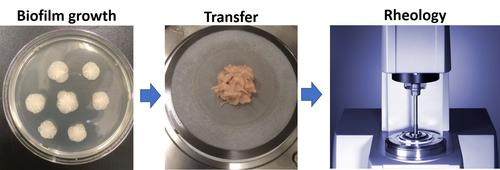Biofilm matrix is a complex mixture of extracellular polysaccharides, accessory proteins, and in some cases, extracellular DNA. Similar to synthetic hydrogels, biofilms are composed primarily of water (90%), yet they possess structural integrity and they protect biofilm-dwelling cells from external perturbations such as biocides, shear flows, phagocytosis, and invasion by other bacterial species. We are interested in how bacterial cells build such dynamic, living materials as they grow into biofilms, and how such living materials differ from classic, inanimate materials. We use a combination of mechanical measurements, mutagenesis, and high-resolution imaging tools to answer this question. Ultimately, we will take advantage of what we learn about biofilm structure and mechanics to design new functional materials.

Figure 1: Procedure for measuring biofilm mechanics.
In particular, we are interested in how to transform our basic understanding of biofilm-material interactions into practical procedures to remove harmful biofilms, for example those grown on a medical device. We have developed a capillary peeling method to gently peel the biofilm off in its entirety (Yan et al., 2018). This simple method applies to a variety of surfaces including metals, hydrogels, and membranes and to biofilms formed by different bacterial species.
Movie 1: Capillary peeling of a biofilm (green) grown on an agar substrate for 2 days. As the hydrophobic biofilm slowly approaches water, it peels off and floats at the air-water interface.
Click here to watch how boifilms can be peeled off and transfered onto another surface.